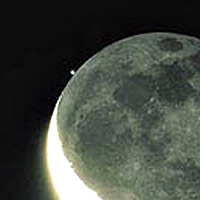
Spica (upper left) grazing the Moon's north polar region 12 years ago. 'We observed the occultation of Spica early in the morning of November 30, 1994, from Central Tokyo,' wrote photographer Motomaru Shirao. 'The appearance of Spica was very beautiful, because the Moon was thin and the earthshine was obvious.' Spica's icy blue-white color contrasted with the Moon's yellowish white.
The bright edge of the waning gibbous Moon will occult 1st-magnitude Spica this Friday night, February 17, 2006, for the Canadian Maritimes — and then, more spectacularly, Spica will reappear from behind the Moon's dark edge for observers across a larger region of eastern North America. The Moon will be low in the east-southeastern sky.
Detailed predictions for many cities and towns (in Universal Time) have been posted by the International Occultation Timing Association in a table (click here). The table has a brief first section for the star's disappearance and a longer list for the reappearance. In the table:
Times are given to the second in Universal Time (UT or GMT). To convert this to your local civil (clock) time, remember that 0:00 UT is 8:00 p.m. Atlantic Standard Time, 7:00 p.m. Eastern Standard Time, 6:00 p.m. Central Standard Time, on the evening of the previous date (that is, on the evening of the 17th local date in North America).
Next are given the Sun's altitude (blank in every case; the Sun is far below the horizon), the Moon's altitude in degrees above the horizon, and the Moon's azimuth (in degrees, counting from the north point on your horizon around through the east point and on toward the south).
Next is the "cusp angle" on the Moon where the star disappears or reappears. This is the number of degrees counting around the Moon's limb from the south (S) or north (N) cusp (where the terminator meets the Moon's limb). Negative values are on the bright limb, positive values are on the dark limb. For reappearances especially, this tells exactly where to be watching with your telescope.
And that's all that really matters. Good luck! And if you get good pictures, please send 'em! Mail them to macrobert [at] SkyandTelescope.com
 0
0
Comments
You must be logged in to post a comment.